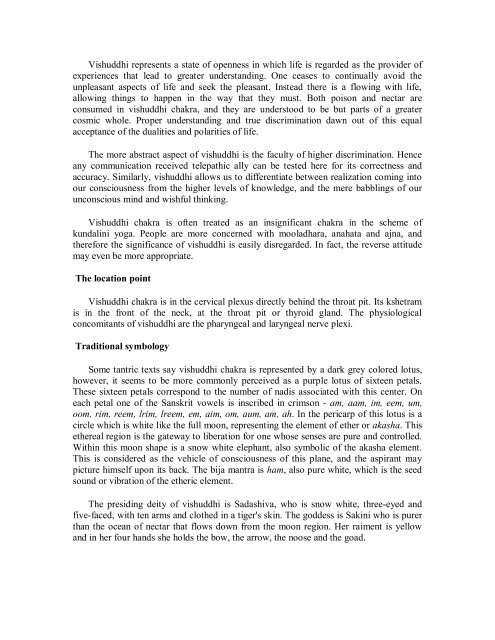Kundalini.Tantra.by.Satyananda.Saraswati
You also want an ePaper? Increase the reach of your titles
YUMPU automatically turns print PDFs into web optimized ePapers that Google loves.
Vishuddhi represents a state of openness in which life is regarded as the provider of<br />
experiences that lead to greater understanding. One ceases to continually avoid the<br />
unpleasant aspects of life and seek the pleasant. Instead there is a flowing with life,<br />
allowing things to happen in the way that they must. Both poison and nectar are<br />
consumed in vishuddhi chakra, and they are understood to be but parts of a greater<br />
cosmic whole. Proper understanding and true discrimination dawn out of this equal<br />
acceptance of the dualities and polarities of life.<br />
The more abstract aspect of vishuddhi is the faculty of higher discrimination. Hence<br />
any communication received telepathic ally can be tested here for its correctness and<br />
accuracy. Similarly, vishuddhi allows us to differentiate between realization coming into<br />
our consciousness from the higher levels of knowledge, and the mere babblings of our<br />
unconscious mind and wishful thinking.<br />
Vishuddhi chakra is often treated as an insignificant chakra in the scheme of<br />
kundalini yoga. People are more concerned with mooladhara, anahata and ajna, and<br />
therefore the significance of vishuddhi is easily disregarded. In fact, the reverse attitude<br />
may even be more appropriate.<br />
The location point<br />
Vishuddhi chakra is in the cervical plexus directly behind the throat pit. Its kshetram<br />
is in the front of the neck, at the throat pit or thyroid gland. The physiological<br />
concomitants of vishuddhi are the pharyngeal and laryngeal nerve plexi.<br />
Traditional symbology<br />
Some tantric texts say vishuddhi chakra is represented <strong>by</strong> a dark grey colored lotus,<br />
however, it seems to be more commonly perceived as a purple lotus of sixteen petals.<br />
These sixteen petals correspond to the number of nadis associated with this center. On<br />
each petal one of the Sanskrit vowels is inscribed in crimson - am, aam, im, eem, um,<br />
ооm, rim, reem, lrim, lreem, em, aim, om, aum, am, ah. In the pericarp of this lotus is a<br />
circle which is white like the full moon, representing the element of ether or akasha. This<br />
ethereal region is the gateway to liberation for one whose senses are pure and controlled.<br />
Within this moon shape is a snow white elephant, also symbolic of the akasha element.<br />
This is considered as the vehicle of consciousness of this plane, and the aspirant may<br />
picture himself upon its back. The bija mantra is ham, also pure white, which is the seed<br />
sound or vibration of the etheric element.<br />
The presiding deity of vishuddhi is Sadashiva, who is snow white, three-eyed and<br />
five-faced, with ten arms and clothed in a tiger's skin. The goddess is Sakini who is purer<br />
than the ocean of nectar that flows down from the moon region. Her raiment is yellow<br />
and in her four hands she holds the bow, the arrow, the noose and the goad.














![[Lonely Planet] Sri Lanka](https://img.yumpu.com/59845622/1/169x260/lonely-planet-sri-lanka.jpg?quality=85)


